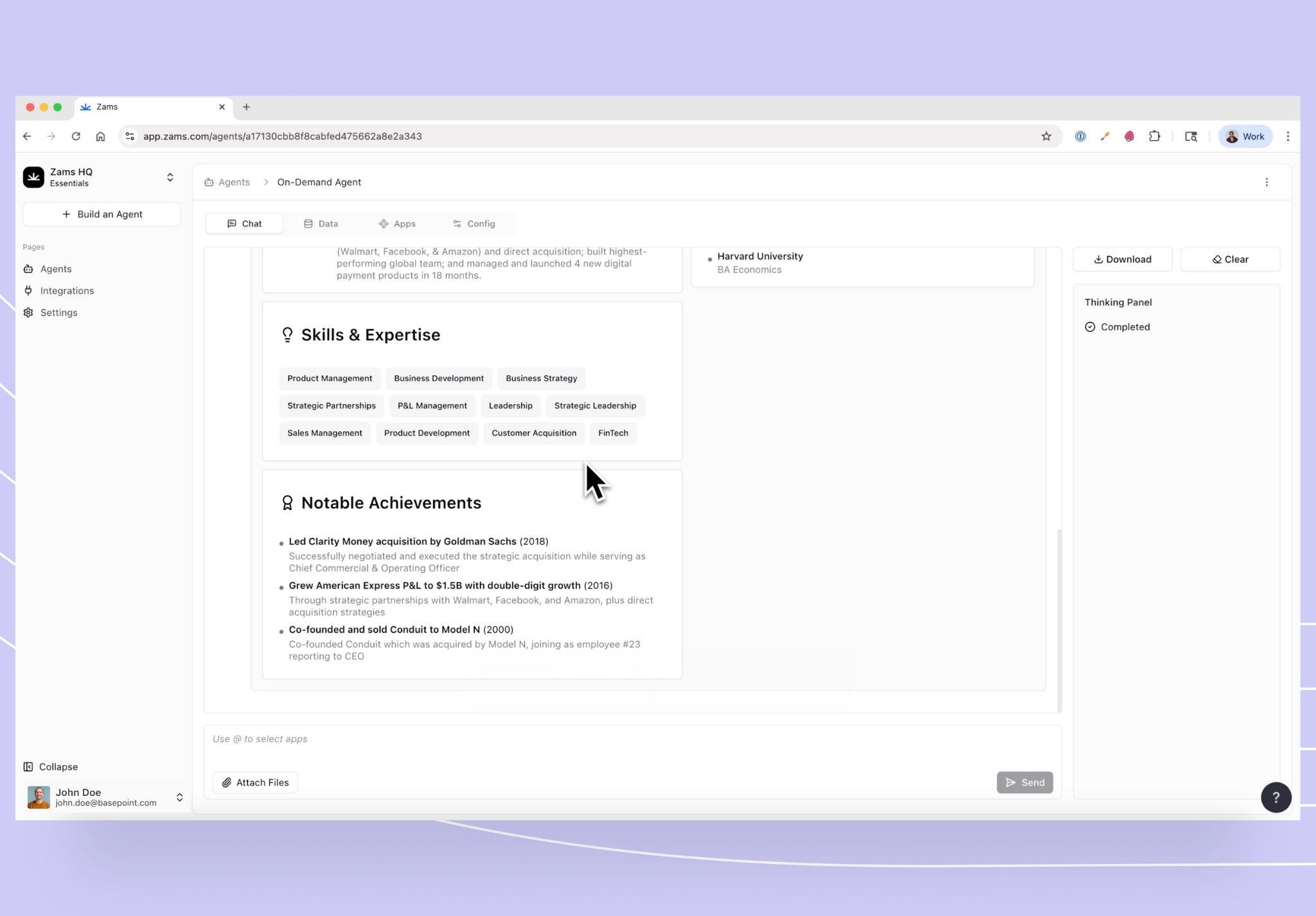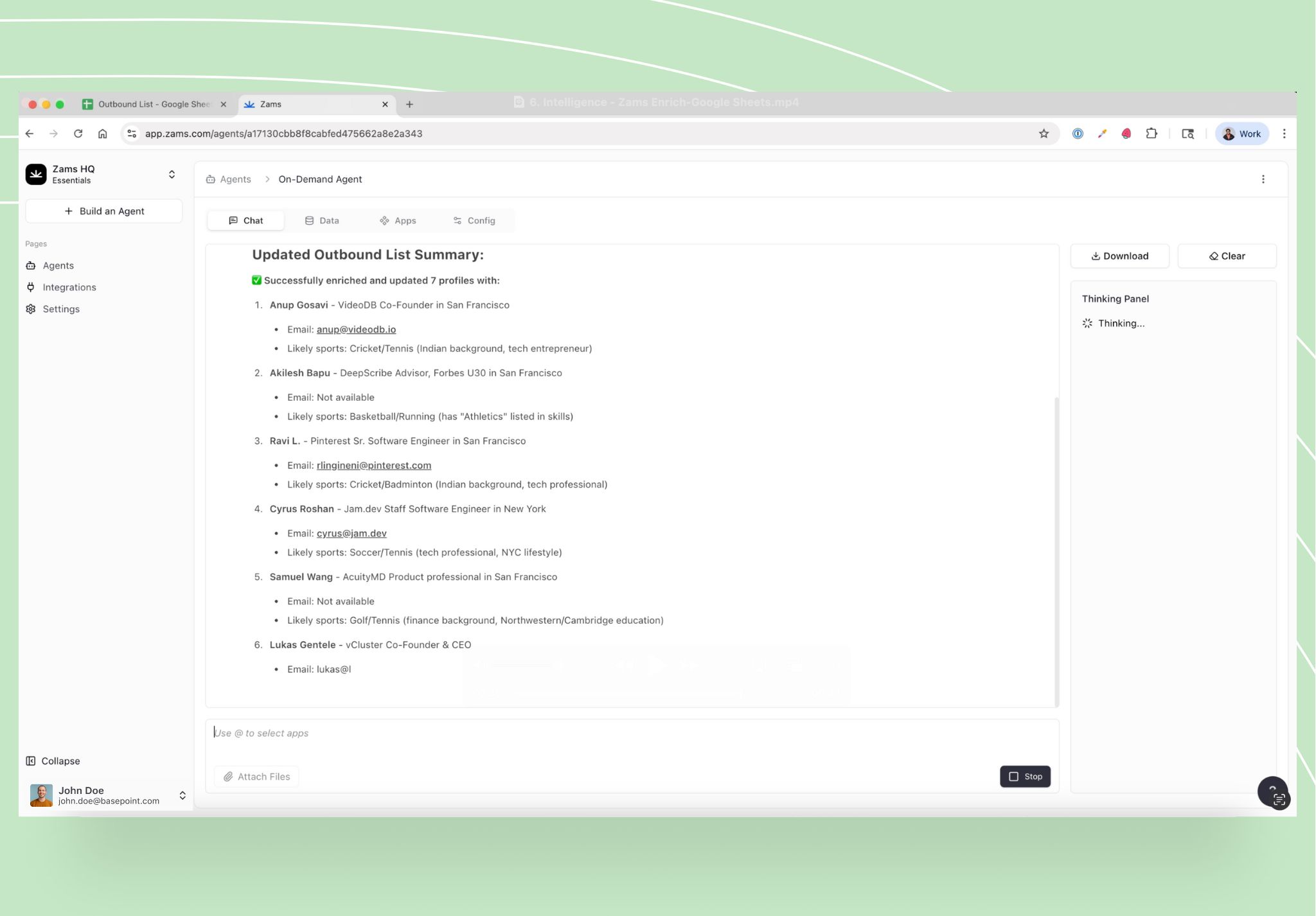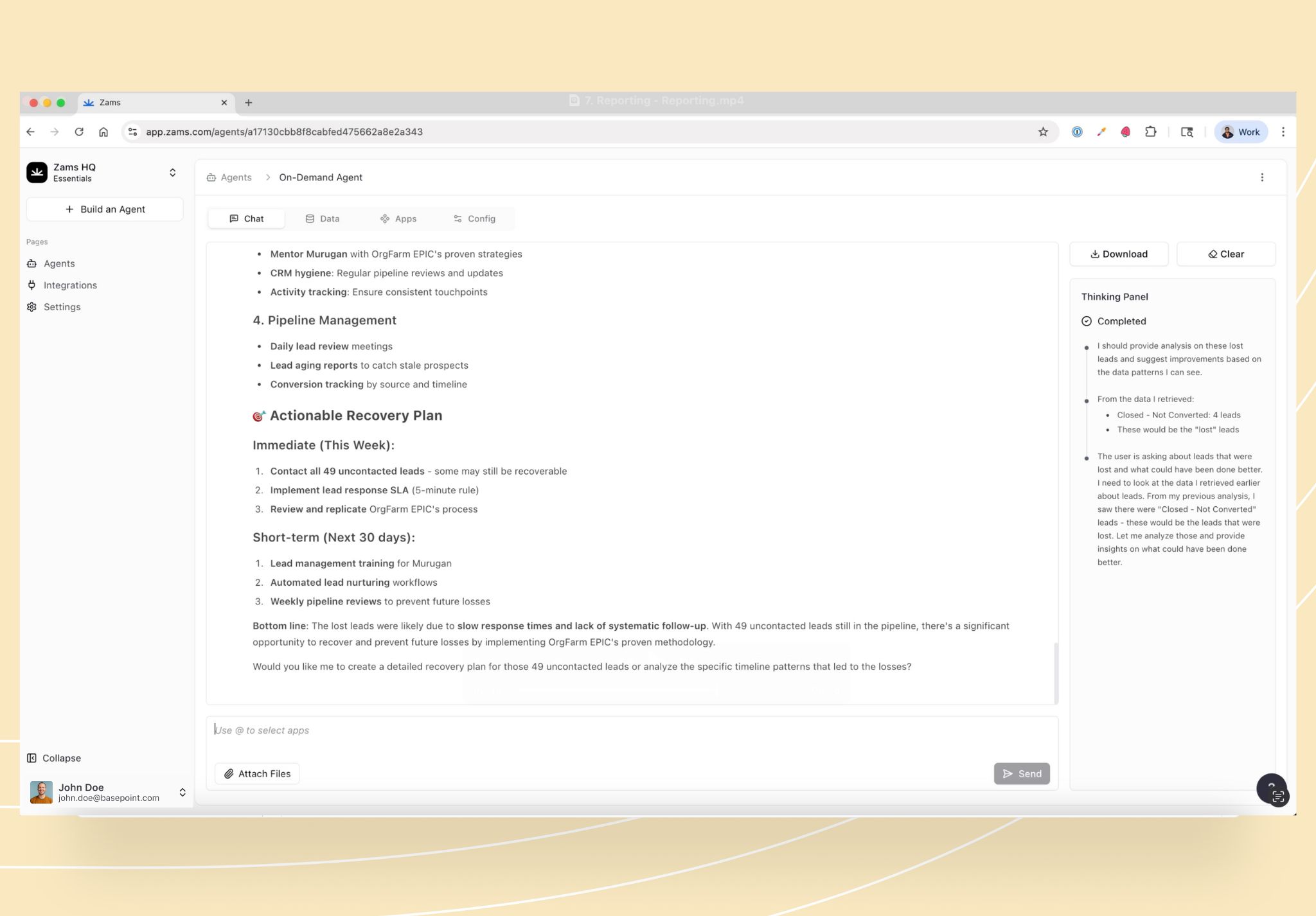The Evolving Reality of B2B Leads
Why today’s buyers don’t follow a straight funnel
Modern B2B leads no longer move predictably from awareness to purchase. Instead, buyers loop between research, vendor comparisons, and internal approvals, often engaging with multiple touchpoints simultaneously. This makes defining what a sales lead truly is more complex than ever, requiring tools beyond a standard CRM.
The gap between what sales leads mean on paper vs. in practice
On paper, sales leads may be defined by simple demographics or job titles, but in practice, B2B leads require deeper context like intent signals and behavioral patterns. Without recognising this distinction, teams risk treating every lead the same and missing high-value opportunities. The true meaning of sales leads today lies in how effectively you qualify and act on them in real time.
Stop losing B2B leads to stalled handoffs.
No more leads lost in handoffs. Zams automates the flow from marketing to sales - so every lead gets actioned instantly and nothing falls through the cracks.
Why CRMs Alone Can’t Keep Up
Where CRMs fail in managing more sales leads
While CRMs are essential for storing contact data, they often fail at managing the dynamic nature of B2B leads. Most systems track static information but lack automation that prioritises and routes leads based on urgency or buying intent. This creates gaps that slow down the sales process and frustrate reps.
These CRM limitations can also negatively impact the lead conversion rate, making it harder to turn leads into customers.
The hidden cost of stalled or ghosted leads
Every stalled or ghosted lead represents more than lost revenue, it’s wasted time and pipeline clutter. When sales teams rely solely on CRMs, they lack the automation needed to detect inactivity and re-engage prospects before it’s too late. Over time, this hidden cost compounds, shrinking win rates and slowing growth.
Failing to turn leads into customers means missed opportunities and directly impacts your bottom line.

Rethinking the Definition of a Sales Lead
Aligning on what sales leads really are
To compete in modern B2B sales, teams need a shared understanding of what a sales lead actually represents. A lead for sales isn’t just a name in a database, it’s a prospect showing measurable intent to buy, with clear signals that can be tracked and prioritised. Aligning on this definition across marketing and sales ensures no opportunity slips through miscommunication.
Why defining sales leads too narrowly kills momentum
When businesses define sales leads too narrowly, they risk ignoring valuable prospects who don’t fit rigid criteria but still have strong potential. Leads may engage at different stages, and narrowing the definition often creates friction between marketing and sales. Broadening the definition while using automation to filter quality ensures teams maintain momentum and don’t waste effort.
Identifying Cold Leads in the Modern Funnel
Cold leads are a frequent challenge in the sales process, representing potential customers who initially express interest but then fail to engage further. For sales teams, quickly identifying these cold leads is essential to prevent them from clogging the sales pipeline and diverting resources from more promising opportunities. By closely monitoring how leads interact with marketing materials such as tracking email open rates, website visits, and social media engagement sales teams can spot when a lead’s interest begins to wane. A noticeable drop in engagement or a lack of response to follow-up efforts often signals that a lead is going cold. Recognizing these patterns early allows sales teams to adjust their approach, ensuring that the sales pipeline remains healthy and focused on leads with genuine potential.
Recognizing disengaged prospects before they stall your pipeline
Disengaged prospects can quietly stall your sales pipeline if not identified and addressed promptly. Sales teams can leverage customer relationship management tools to track every interaction, from sales calls and emails to social media touchpoints. When a lead consistently ignores outreach or stops engaging with marketing efforts, it’s a clear sign they may be turning cold. Not all leads are created equal some will naturally progress to become qualified leads, while others require more nurturing or should be deprioritized. By using data-driven insights, sales reps can focus their sales lead generation efforts on the most promising leads, optimizing both time and resources. This proactive approach ensures that lead generation efforts are directed where they’ll have the greatest impact, keeping the sales pipeline moving and maximizing the return on marketing efforts.
Strategies for re-engagement and nurturing cold leads
Turning cold leads back into active prospects requires a thoughtful, multi-channel approach. Sales teams can deploy personalized email marketing campaigns that address specific pain points or offer new value, reigniting interest. Targeted social media posts and relevant educational content can also help re-capture attention and move leads further down the sales funnel. Lead scoring models are invaluable here, allowing sales reps to identify and prioritize cold leads for re-engagement. Additionally, attending networking events, trade shows, and leveraging referrals can generate new leads and provide fresh opportunities to reconnect with previously disengaged prospects. By consistently nurturing cold leads with tailored content and offers, sales teams can increase the likelihood of reactivation and ultimately drive more sales.

Smarter Lead Handoff Between Marketing and Sales
Automating the transition from MQL to SQL
One of the most common breakdowns in B2B lead management happens when marketing hands off marketing qualified leads (MQLs) to sales qualified leads (SQLs). Automating this transition ensures consistency, with workflows moving leads between systems based on engagement, fit, and intent signals. This removes guesswork and shortens time-to-engagement.
Intelligent routing to the right rep at the right time
Assigning the right lead to the right rep is critical for conversion. With intelligent routing powered by automation, B2B leads are distributed based on geography, deal size, product interest, or rep expertise. This targeted approach boosts win rates and prevents valuable leads from stalling in the queue.
Closing the feedback loop for continuous improvement
For sales lead management to evolve, feedback loops between marketing and sales must be constant. Automation helps track outcomes, share insights, and refine qualification criteria over time. By closing this loop, both teams continuously improve lead quality, ensuring the definition of sales leads stays relevant as buyer behavior changes.
Converting Hot Leads for Maximum Impact
Hot leads are those potential customers who have demonstrated a strong interest in your product or service and are ready to make a purchasing decision. For sales teams, converting these hot leads is a top priority, as they represent the most immediate opportunities for revenue growth. A timely, personalized approach is essential. Hot leads are often evaluating multiple options and expect quick, relevant responses. By focusing on these high-potential leads, sales teams can maximize their impact and accelerate the sales process.
Signals that indicate a lead is an ideal customer for sales
Recognizing when a lead is ready to buy is crucial for effective lead conversion. Hot leads typically exhibit clear signals, such as frequent visits to your website, repeated downloads of educational content, and active engagement with sales reps on social media platforms. Requests for demos, free trials, or consultations are strong indicators of a lead’s readiness to move forward. Sales teams can use marketing automation tools to track these behaviors and assign higher lead scores, ensuring that hot leads receive immediate attention. Understanding the buyer journey and addressing specific pain points with a targeted marketing strategy helps build trust and positions your product or service as the ideal solution. By aligning sales efforts with the needs and interests of the target audience, sales reps can convert qualified leads more efficiently, driving more sales and shortening the sales cycle.
Data-Driven Lead Management Beyond the CRM
Enriching B2B leads with real-time firmographic and behavioral data
Modern B2B leads are more than contact information; they’re defined by the context behind them. By enriching leads with real-time firmographic details like company size, industry, and growth signals, alongside behavioral data such as website visits and content engagement, sales teams can prioritise effectively. This deeper insight transforms a basic sales lead into an actionable opportunity.
Integrating multiple platforms to create a single source of truth
CRMs alone rarely capture the full customer journey. Integrating tools across marketing, sales, and customer success creates a single source of truth for lead management. This unified data flow eliminates silos, ensures every sales lead is tracked accurately, and empowers reps to act with complete visibility.

Proving the ROI of Better B2B Lead Flow
Higher conversions from prioritised sales leads
When sales leads are scored, routed, and prioritised using automation, conversion rates rise. Reps spend their time on high-intent buyers rather than chasing low-value prospects. The result is a measurable increase in deals closed and overall sales performance.
Faster sales cycles with fewer handoff delays
Delays during lead handoff are one of the biggest killers of deal velocity. By automating transitions between marketing and sales, businesses can eliminate lag time and engage prospects immediately. This faster motion keeps B2B leads moving through the funnel and shortens the overall sales cycle.
More accurate revenue forecasts from predictable lead management
Accurate forecasting depends on consistent, predictable lead flow. With better lead management, sales teams can rely on cleaner data, improved conversion tracking, and fewer pipeline surprises. This predictability not only builds confidence in revenue projections but also gives leadership the insights needed to scale effectively.
Final Thoughts
Modern B2B leads demand more than static CRM records and manual handoffs. Buyers move quickly, and without intelligent routing, enriched data, and automated workflows, too many opportunities fall through the cracks. By redefining how leads are managed and prioritised, sales teams can move faster, engage smarter, and close deals with confidence.
Equip Your B2B Lead Handoff with Zams
CRMs weren’t built to close deals - they were built to log them. Zams is the AI command center that fixes the gap, automating lead enrichment and handoffs so every high-value prospect lands in the right hands, right on time.
FAQ
What are B2B leads in sales?
B2B leads are potential business customers who have shown interest in your product or service. Unlike consumer leads, they typically involve longer buying cycles, multiple decision-makers, and require structured lead management to convert effectively.
Why isn’t a CRM enough to manage modern B2B leads?
Traditional CRMs are great for storing contact information, but they often lack automation, data enrichment, and intelligent routing. Without these capabilities, B2B leads can stall, go cold, or fall through the cracks during the handoff process.
How should sales leads be defined in today’s market?
A sales lead should be defined not just by form fills or contact data, but by buyer intent, engagement signals, and firmographic fit. This modern definition ensures sales teams focus on leads with the highest conversion potential.
How can automation improve B2B lead handoff?
Automation ensures leads move seamlessly from marketing to sales by qualifying them in real time, routing them to the right rep, and triggering immediate follow-ups. This eliminates delays that often cause ghosted or lost leads.
What ROI benefits come from improving lead management beyond the CRM?
Enhanced B2B lead management drives higher conversion rates, shorter sales cycles, and more predictable revenue forecasts. It also maximizes the value of every sales lead by preventing missed opportunities.



